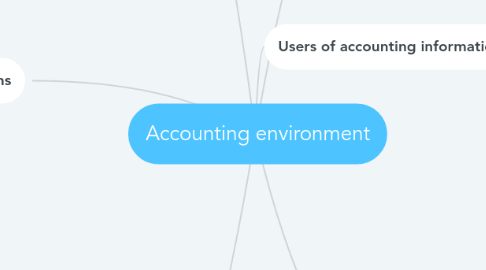
1. Types of accounting information
1.1. Financial accounting
1.1.1. Describes financial resources, obligation and activities of an economic entity
1.1.2. Assist investors and creditors in making decisions
1.2. Management accounting
1.2.1. involves the development and interpretation of accounting information
1.2.2. Assist management in operating the business
1.3. Tax accounting
1.3.1. Based on financial accounting information
1.3.2. Complies with specialized legal requirements that relate to a company's responsibility to pay an appropriate amount
1.3.3. Most challenging aspect is planing tax
1.3.3.1. Anticipating tax effects of business transactions
1.3.3.2. Structuring these transactions in manner that will minimize income tax burden
2. Professional organizations
2.1. Financial Accounting Standard Board (FASB)
2.1.1. Formed in 1972
2.1.2. An independent body relying on the Financial Accounting Foundation for selection of its members and approval of its budgets
2.1.3. Issues Statements of Financial Accounting Standard and Interpretations and several types of pronouncements
2.2. Securities and Exchange Commission (SEC)
2.2.1. A governmental agency
2.2.2. Establish accounting principles and financial reporting requirements for publicly owned corporations
2.2.3. FASB needs support from SEC
2.3. American Institute of Certified Public Accountants (AICPA)
2.3.1. Professional association of certified public accountants
2.3.2. provides members with resources and information to enable them to provide valuable services in the highest professional manner
2.4. American Accounting Association (AAA)
2.4.1. An organization primarily for accounting educators
2.4.2. Develop accounting theory, encourage ,sponsor accounting research and improve education in accounting
3. General accepted accouting principles
3.1. Include conventions, rules and procedures necessary to define accepted accounting practice at a particular time
3.2. Conceptual Framwork
3.2.1. Describe nature, function and limits of financial accounting and to be used as as guideline that will lead to consistent standard
3.2.2. Components of Conceptual Framwork
3.2.2.1. Objectives
3.2.2.2. Qualitative characteristics
3.2.2.3. Elements
3.2.2.4. Recognition
3.2.2.5. Measurment
3.2.2.6. Financial statements
3.2.2.7. Earnings
3.2.2.8. Funds
3.2.2.9. Funds flow
3.2.2.10. Liquidity
3.2.3. New conceptual framework for International Financial Reporting Standard and GAAP
3.2.3.1. Sets out the concepts that underlie the preparation and presentation of financial statements for external users
4. Definition
4.1. Accounting
4.1.1. Process of identifying, measuring and communicating economic information
4.1.2. Permit informed judgement and decisions by users of information
4.2. Accounting environment
4.2.1. consists of the influences, constraints and demands that are imposed on conceptual foundation and implementation of that foundation as a professional activity
5. Users of accounting information
5.1. Internal users
5.1.1. Mostly, the management of an equity
5.1.1.1. Group of managers
5.1.1.2. Responsible for operating the company and achieving the company's goals
5.1.1.3. Decide what to do, how to do and whether the results match original plans
5.2. Externa users
5.2.1. have financial interest in business and need accounting information to make a decision
5.2.1.1. Investors
5.2.1.1.1. who have invested or may invest in a business
5.2.1.2. Creditors
5.2.1.2.1. Who have lent or may lend money to a business
6. Concept and accounting principles
6.1. 4 basic environmental concepts
6.1.1. Business entity
6.1.1.1. Business entity is regarded as separate from the personal activites of its owners
6.1.2. Money measurement
6.1.2.1. In financial accounting, a record is made only if information can be express in monetary
6.1.3. Going- concern
6.1.3.1. Unless there is good evidence to the contrary, accounting assumes that an equity is a going-concern that it will continue to operate for an indefinetly long period in the future
6.1.4. Accounting period
6.1.4.1. Accounting measures activities for a specified interval of time
6.1.4.2. For reporting purpose, 1 year is the usual accounting period
6.2. 3 principles
6.2.1. The cost principle
6.2.1.1. All assets are initially recorded at their cost
6.2.2. The realization principle ( revenue principle)
6.2.2.1. The amount recognized as revenue is the amount that is reasonably certain to be realized or the revenue should be recognized at the time goods and servies are rendered
6.2.3. The matching principle
6.2.3.1. in measuring net income for a period, revenue should be offset by all the expenses incurred in producing that revenue

